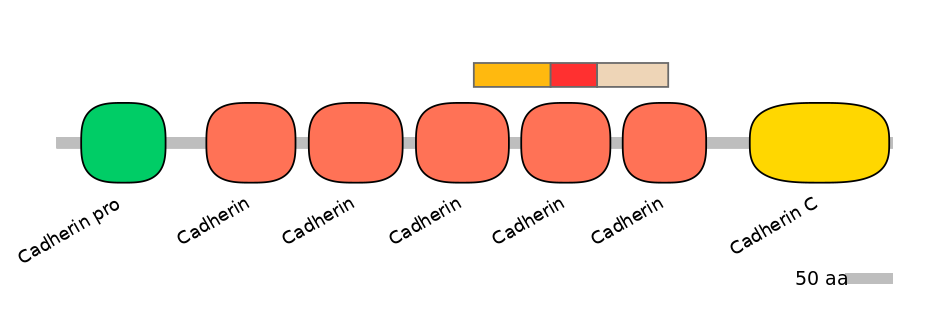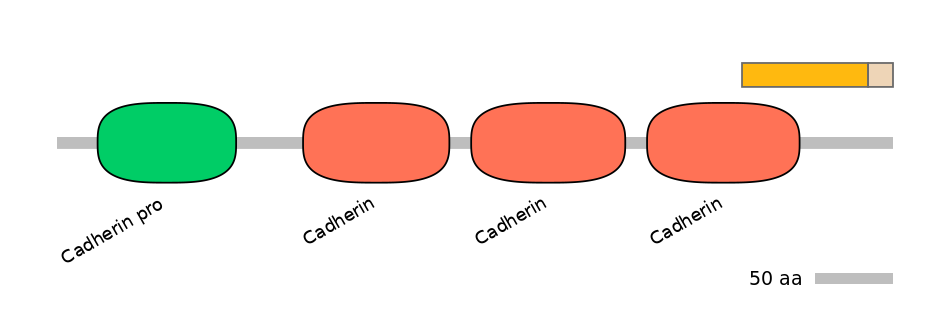HsaEX0014149 @ hg38
Exon Skipping
Gene
ENSG00000039068 | CDH1
Description
cadherin 1 [Source:HGNC Symbol;Acc:HGNC:1748]
Coordinates
chr16:68815515-68822225:+
Coord C1 exon
chr16:68815515-68815759
Coord A exon
chr16:68819280-68819425
Coord C2 exon
chr16:68822001-68822225
Length
146 bp
Sequences
Splice sites
3' ss Seq
CAGAGCTTGTCCCCGTTCAGATA
3' ss Score
5.13
5' ss Seq
ATGGTAAGG
5' ss Score
9.33
Exon sequences
Seq C1 exon
GGCTTGGATTTTGAGGCCAAGCAGCAGTACATTCTACACGTAGCAGTGACGAATGTGGTACCTTTTGAGGTCTCTCTCACCACCTCCACAGCCACCGTCACCGTGGATGTGCTGGATGTGAATGAAGCCCCCATCTTTGTGCCTCCTGAAAAGAGAGTGGAAGTGTCCGAGGACTTTGGCGTGGGCCAGGAAATCACATCCTACACTGCCCAGGAGCCAGACACATTTATGGAACAGAAAATAAC
Seq A exon
ATATCGGATTTGGAGAGACACTGCCAACTGGCTGGAGATTAATCCGGACACTGGTGCCATTTCCACTCGGGCTGAGCTGGACAGGGAGGATTTTGAGCACGTGAAGAACAGCACGTACACAGCCCTAATCATAGCTACAGACAATG
Seq C2 exon
GTTCTCCAGTTGCTACTGGAACAGGGACACTTCTGCTGATCCTGTCTGATGTGAATGACAACGCCCCCATACCAGAACCTCGAACTATATTCTTCTGTGAGAGGAATCCAAAGCCTCAGGTCATAAACATCATTGATGCAGACCTTCCTCCCAATACATCTCCCTTCACAGCAGAACTAACACACGGGGCGAGTGCCAACTGGACCATTCAGTACAACGACCCAA
VastDB Features
Vast-tools module Information
Secondary ID
ENSG00000039068_CASSETTE4
Average complexity
S
Mappability confidence:
100%=100=100%
Protein Impact
ORF disruption upon sequence exclusion
No structure available
Features
Disorder rate (Iupred):
C1=0.068 A=0.165 C2=0.082
Domain overlap (PFAM):
C1:
PF0002812=Cadherin=PD(37.4=45.1),PF0002812=Cadherin=PU(32.6=37.8)
A:
PF0002812=Cadherin=FE(51.6=100)
C2:
PF0002812=Cadherin=PD(14.7=18.4),PF0002812=Cadherin=PU(53.9=63.2)


Other Skipping Isoforms:
NA
Associated events
Other assemblies
Conservation
Fruitfly
(dm6)
No conservation detected
Primers PCR
Suggestions for RT-PCR validation
F:
GAGGTCTCTCTCACCACCTCC
R:
GGGGCGTTGTCATTCACATCA
Band lengths:
246-392
Functional annotations
There are 2 annotated functions for this event
PMID: 19745069
The study used a microarray technique to screen for genes that up-regulate their RNA signal upon nonsense-mediated decay pathway blockade in chronic lymphocytic leukemia (CLL) specimens and identified an E-cadherin transcript with premature termination codon (PTC). Sequencing revealed an aberrant E-cadherin transcript lacking exon 11 (HsaEX0014149), resulting in a frameshift and PTC. The aberrant E-cadherin transcript was also identified in normal B cells, but occurred at a much lower level compared with CLL cells. In CLL specimens, E-cadherin expression was depressed more than 50% in 62% cases (relative to normal B cells). By real-time polymerase chain reaction analysis, the relative amounts of wild-type transcript inversely correlated with amounts of aberrant transcript (P = .018). Ectopic expression of E-cadherin in CLL specimens containing high amounts of aberrant transcript resulted in down-regulation of the wnt?beta-catenin pathway reporter, a pathway known to be up-regulated in CLL. These data point to a novel mechanism of E-cadherin gene inactivation, with CLL cells displaying a higher proportion of aberrant nonfunctional transcripts and resulting up-regulation of the wnt?beta-catenin pathway.
PMID: 21764905
[Disease and regulation]. The study analyzed the role of E-cadherin missplicing as a mechanism of its downregulation by analyzing a misspliced E-cadherin transcript that lacks exon 11 (HsaEX0014149) of this gene. This results in a frameshift and a premature termination codon that targets this transcript for degradation. Tumor tissues, including breast (20%, n = 9), prostate (30%, n = 9) and head and neck (75%, n = 8) cancer, express the exon 11-skipped transcripts (vs. nonmalignant controls) and its levels inversely correlate with E-cadherin expression. This is a novel mechanism of E-cadherin downregulation by missplicing in tumor cells, which is observed in highly prevalent human tumors. In the head and neck cancer model, nontumorigenic keratinocytes express exon 11-skipped splice product two- to sixfold lower than the head and neck tumor cell lines. Mechanistic studies reveal that SFRS2 (SC35), a splicing factor, as one of the regulators that increases missplicing and downregulates E-cadherin expression. Furthermore, this splicing factor was found to be overexpressed in 5 of 7 head and neck cell lines and primary head and neck tumors. Also, methylation of E-cadherin gene acts as a regulator of this aberrant splicing process. In 2 head and neck cell lines, wild-type transcript expression increased 16- to 25-folds, whereas the percentage of exon 11-skipped transcripts in both the cell lines decreased five- to 30-folds when cells were treated with a hypomethylating agent, azacytidine. These findings reveal that promoter methylation and an upregulated splicing factor (SFRS2) are involved in the E-cadherin missplicing in tumors.
GENOMIC CONTEXT[edit]
INCLUSION PATTERN[edit]
SPECIAL DATASETS
- The Cancer Genome Atlas (TCGA)
- Genotype-Tissue Expression Project (GTEx)
- Autistic and control brains
- Pre-implantation embryo development